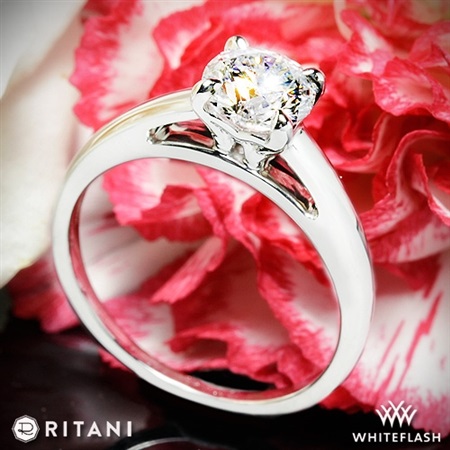What You Need to Know About Tension Settings
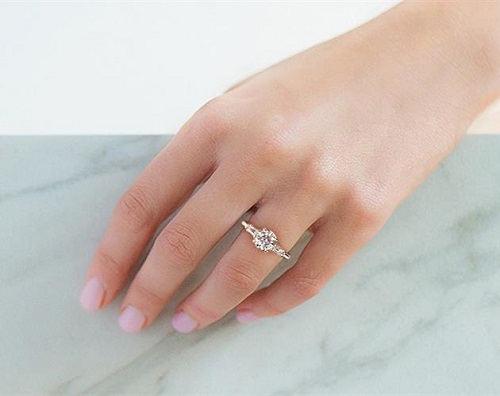
Diamond Sizes on Hands
November 21, 2017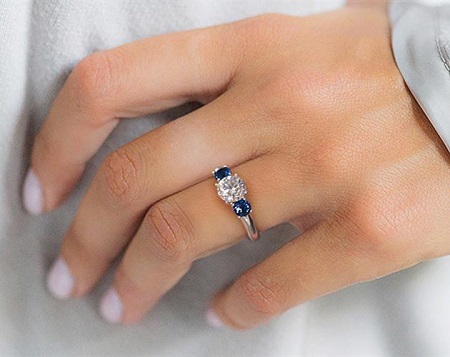
Timeless Pieces – Classic Style Engagement Rings
November 21, 2017What You Need to Know About Tension Settings
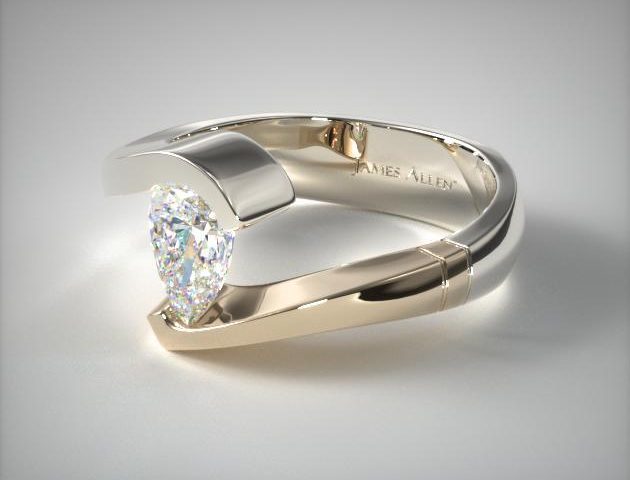
This page contains references to diamonds or engagement rings from different companies. Sometimes I do receive a commission when you click on links and buy the products.
The unique character of tension rings settings makes them truly stand out from the crowd. There is nowhere for the diamond to hide – it is displayed in complete and unadulterated glory. It’s mesmerizing. But, what are tension set engagement rings? How can you be sure they are a secure option for your chosen diamond? In short, why are tension rings settings so spectacular?
What is a Tension Set Ring?
If you take a look at most traditional engagement rings, whether they are a solitaire (single stone), or have a central stone and accompanying smaller ones, you’ll notice that there are prongs, baskets, or clasps holding the diamond in place. With a quick glance you can quickly tell exactly how the center stone is secured.
Tension set rings on the other hand won’t have these prongs, baskets, or clasps. Instead, the tension and structure of the ring, and notably the band, is the means of holding the diamond in place. It’s like holding something between your forefinger and thumb: the tighter you hold, the more secure the object.
What is a Tension Set Engagement Ring?
For engagement rings, which typically feature a central diamond solitaire, the tension style really shows off the diamond. The diamond is held securely within the opening in the band, and is held there by the pressure being exerted upon it from the two open ends. It’s down to the laws of physics expertly applied by a designer and jeweler.
The overall look is stunning. The center stone looks as if it is floating. The play of light is unhindered, and you see the diamond in all its glory. That said, there are some pros and cons to tension ring settings, and different situations where choosing a tension ring may or may not be the best choice. Let’s run through them.
The Pros of Tension Ring Settings
There are four primary advantages of tension set engagement rings:
- They make a statement: There’s no doubting that tension set diamonds will wow anyone looking at them. They are dramatic and impressive. The ring will be a focus of conversation anywhere you go.
- You can choose your metal: You’re not restricted on the type of metal you can choose to create your setting. You should be able to choose from platinum, yellow gold, white gold and rose gold as easily as you can with more traditional designs. For example, this exquisite Danhov Voltaggio ring available from Whiteflash is available in a full spectrum of metals.
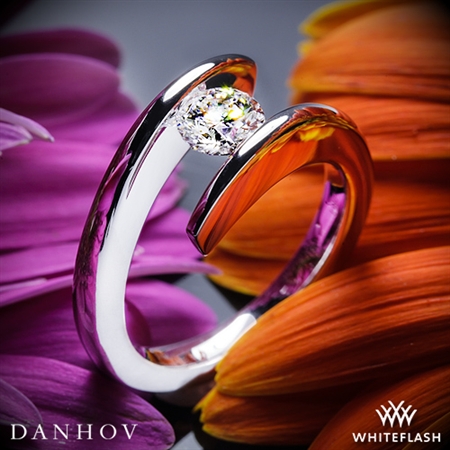
- They are often custom-made: As these rings are more unusual, you’ll find that they are often the result of customization. Therefore, you shouldn’t be restricted to the shape of the center diamond. You should discover that you can choose from any cut and shape you like, including oval and pear.
- The ‘freedom’ of the diamond: With a tension setting you can see the diamond in complete view from every angle. More light can enter the diamond making for a more dazzling display of sparkle. The setting is, in no way, inhibiting the display of the diamond. If you use James Allen’s 360° picture viewer on their tension rings, you can see how you can look at the diamond from all angles.
The Cons of Tension Ring Settings
Then there are three main disadvantages of tension rings:
- Resizing: By their very nature, tension set engagement rings are meant to be worn for life. However, it’s very unusual if an individual doesn’t need their engagement ring resizing at a few different points in time, most notably when they gain or lose weight. This poses a problem for tension ring settings because they are very difficult to resize in comparison with a more traditional ring. Alterations may fundamentally affect the tension and calibration of the measurements holding the center diamond securely. However, it isn’t impossible. A specialized jeweler, such as Whiteflash or James Allen will be able to do this for you.
- Choice of Jewelers: The resizing issue leads us on to the next disadvantage. You won’t have the same selection of jewelers as you would for a simpler setting. However, this works as a natural filter for exceptional retailers. If they list tension settings for sale then you can be sure they are competent and confident jewelers of distinction.
- Security: This drawback predominantly concerns the jewelers themselves, but there is a slightly greater risk of loss of the center diamond, particularly by the unscrupulous. The diamond can, with brute force, be removed without any specialized tools. The warranty should cover this, but it can be difficult to distinguish between the fraudulent and the genuine.
What is Possible with a Tension Setting?
There are, by its nature, some limitations to a tension setting. But it is these limitations which make it so intrinsically unique and eye-catching. I’m going to showcase some of my favorite tension setting designs to show you what is possible.
I’m going to start with the Niessing Tapered Pure Harmony Ring. The reason is that it was Niessing who pioneered the tension ring concept, so they definitely deserve a mention. It was only as recently as the 1970s, hence tension rings are really still considered a modern choice. Whilst I do love the tension rings, and history, associated with Niessing, they are quite true to the original bulky and chunky looks.
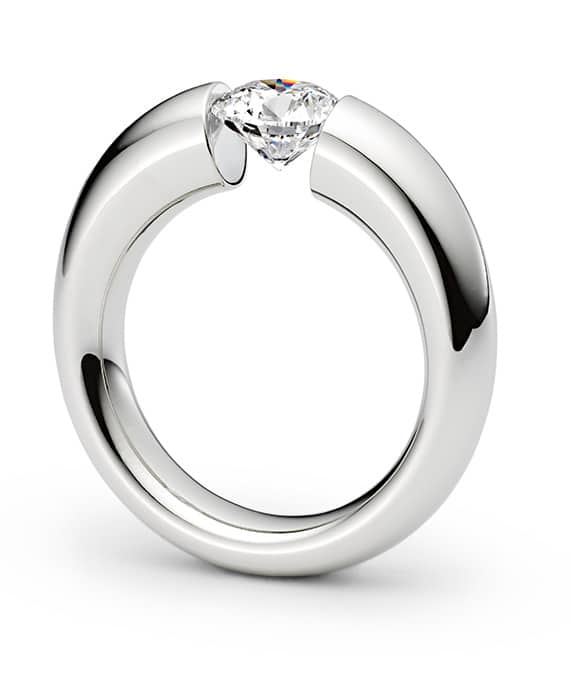
This Danhov Voltaggio ring also has the slightly chunkier look that is associated with tension ring settings, but has the balance a little more in its favor. This one, particularly when paired with a Whiteflash A CUT ABOVE diamond will certainly be striking.
However, if you want something a little more intricate, which blends the contemporary nature of the tension setting with the complexity of an artistic design, then this Hand Engraved Bypass Engagement Ring from James Allen is simply stunning.
You needn’t think that tension ring settings always come with a hefty price tag either, as the Lilly Solitaire Engagement Ring displays.
What to Look for in Tension Set Engagement Rings
These examples should help you to see some of the things you can expect to see in tension ring settings. I particularly urge you to use a reputable jeweler where you can be certain of the workmanship and the manufacturing process. You need to be sure you’ve chosen a reputable jeweler to ensure that the diamond doesn’t just look secure, but is secure. Then look for what you love: the design that strikes you, and reflects your personality.


